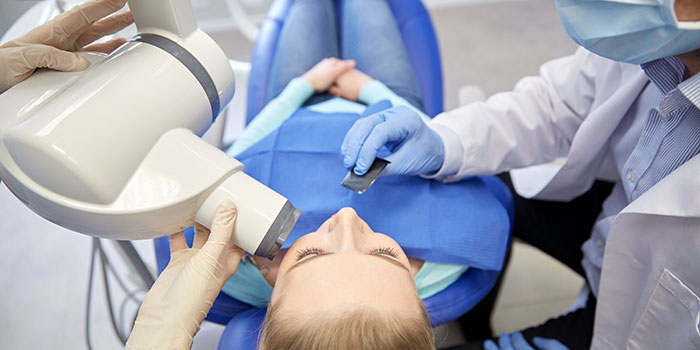November 19, 2019
Dentists typically take an x-ray or radiograph of your teeth to evaluate your oral health. But why do dentists take x-rays? X-rays are a very common tool within the dental industry and are just as important as cleaning your teeth. If you are a new patient, you will more than likely undergo several dental x-rays so that a practitioner can track your progress over a certain period or diagnose an oral condition. Dental x-rays are useful for identifying the internal structures of your teeth and gums which can help identify problems such as tooth decay, bone loss and impacted teeth.
What are x-rays?
An x-ray or radiograph involves the use of high energy radiation to take an image of your body. An x-ray is used in very low doses to help diagnose an injury or disease such as broken bones, tumours and dental decay. A standard x-ray is painless and is well-known for its ability to reveal clear images of your bones and teeth through your skin. X-rays are often part of examinations in a hospital, doctor’s office, dental surgery or at a bedside with a portable x-ray machine.
During this procedure you will be positioned in the dental chair and your dentist will place an x-ray tab into your mouth. Once turned on, the x-ray will travel through your mouth absorbing different tissues whilst recording the data on a computer screen located in the dental surgery.
After taking the x-ray, your dentist will review the images and can show you potential problems on the computer screen.
Following an x-ray, you won’t require much aftercare as it is a quick, pain-free procedure. However, in some instances for x-rays outside of the dental practice, your health practitioner may use a contrast material. This is injected into a joint or blood vessel and you may need to remain under medical care to ensure there is no allergic reaction.
What is the difference between an X-ray and Cone Beam CT?
A traditional x-ray normally produces a single slice image of an area of your body. Traditional x-rays are computerized and record data using a fan-shaped X-ray beam onto image detectors, located around a patient. This enables a practitioner to collect a clear image of your mouth.
On the other hand, a cone beam CT (CBCT) captures a complete volume image in one single rotation of your mouth. This process involves the use of a cone beam which radiates from an x-ray source in the shape of a cone. The computer software then reconstructs the X-ray image to produce a high-resolution 3D image of your mouth.
In addition, cone beam CT utilises a low power fluoroscopy tube which provides continuous imaging throughout a scan. Due to its single turn motion a cone beam CT scan provides practitioners with a much more efficient and quicker scan than a traditional x-ray. Therefore, exposing you to less radiation throughout the process.
Your dentist might take a CBCT scan to see how your wisdom teeth develop, plan for implant placement as well as capture a 3D image of your head, allowing for the identification of any pathologies.

Why do dentists take x-rays?
Dentists may need to take x-rays for several reasons. At Coastal Dental Care, we usually take new routine, decay view images every 2 years. This helps our team to keep track of the condition of your teeth.
Accurate diagnoses
The x-ray images enable dentists to identify internal structures and identify the shape, size, density and texture of your teeth. This is crucial to determining an accurate diagnosis of a medical condition and its exact location.
Your dentist will usually only conduct an x-ray to produce a clear image of the spaces between your teeth. It also helps to identify areas under your gums and existing fillings. Your dentist will then be able to provide you with the right treatment and guidance to resolve your oral condition.
Fast and Safe
An x-ray is painless and often takes less than 5 minutes to complete. Your dentist usually takes one image of your teeth rather than multiple images. As a result, this exposes you to less radiation. Hence, why dentists commonly use x-rays to diagnose oral conditions. Furthermore, if a patient is undertaking an x-ray during pregnancy a dental practitioner may provide you with a leaded apron and thyroid collar. These serve as a precaution to further reduce their exposure to radiation.
Book an appointment today
If you have questions about how x-rays or how our CBCT machines work, ask your dentist at your next visit. You can conveniently book an appointment online 24/7.


